MGT301 Change Management: Research, Evaluation of Change Models
VerifiedAdded on 2023/06/13
|8
|3121
|253
Report
AI Summary
This report delves into change management theory, comparing and evaluating various models such as Lewin's, Beckhard's, Kotter's, the Continuous Change Process Model, and Schein's Steps to Change. It examines current research literature on change management, emphasizing the importance of employee involvement and communication in successful organizational transformations. The report highlights the application of these models in real-world scenarios, such as the Australian banking and airline industries, and the healthcare sector. It concludes by stressing the need for organizations to adopt appropriate change management models to effectively navigate environmental changes and maintain a competitive edge. Desklib provides access to this report and other study resources.
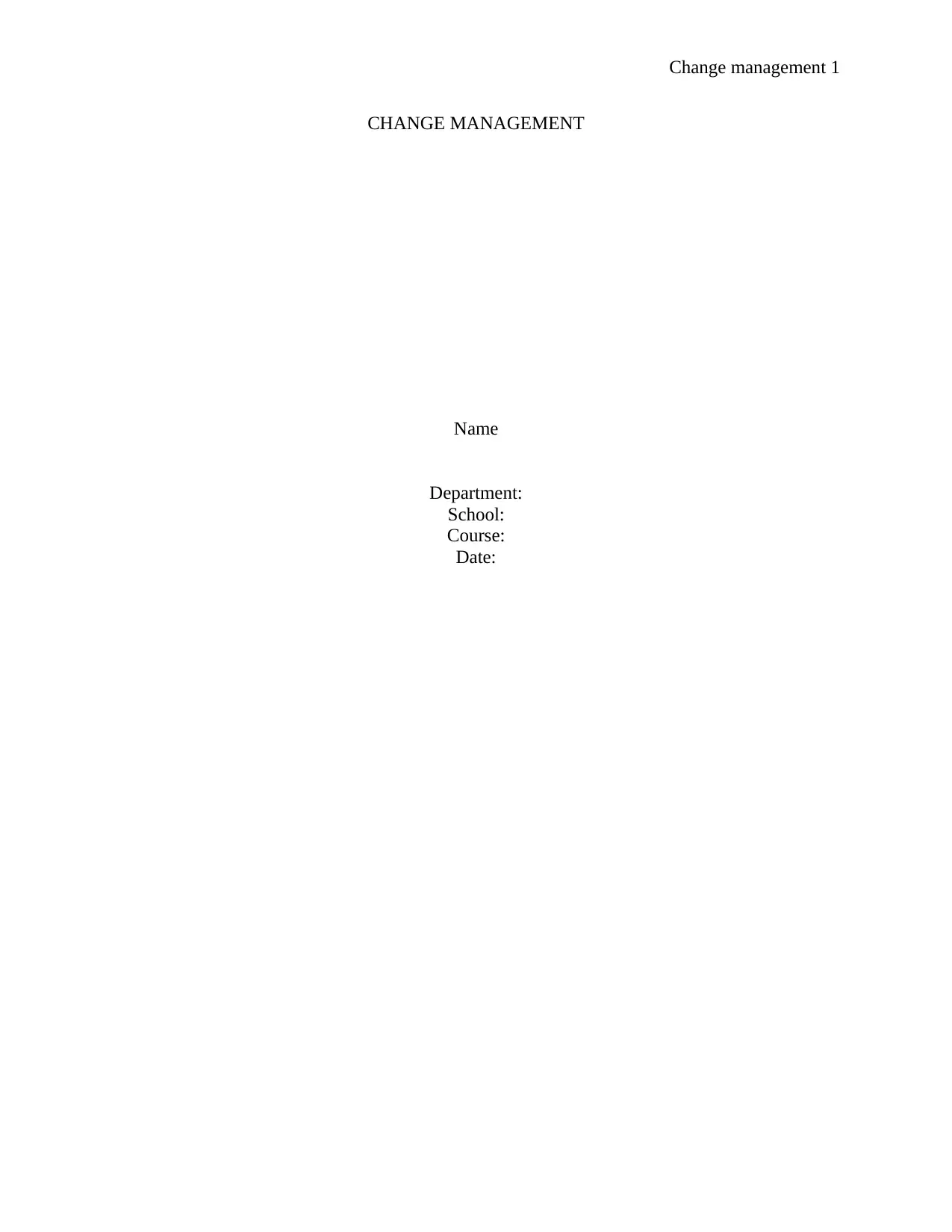
Change management 1
CHANGE MANAGEMENT
Name
Department:
School:
Course:
Date:
CHANGE MANAGEMENT
Name
Department:
School:
Course:
Date:
Paraphrase This Document
Need a fresh take? Get an instant paraphrase of this document with our AI Paraphraser

Change management 2
Executive Summary
In the contemporary world, organisations are experiencing remarkable environmental and
global changes as opposed to earlier days. Hence, the changes have led to the rise of new
economies; the aspect that has steered the availability of looming business opportunities for
various organisations across the globe. Due to the changing world, there has been an emergence
of various factors and initiators that force organisations to embrace change for them to survive in
the market or face extinction. Thus, organisations have been forced to change and align
themselves with the changes in the environment. However, it is hard to initiate and implement a
successful shift within an organisation. Therefore, it is vital for an organisation to adopt an
appropriate approach to help in managing change process effectively and efficiently. The report
aims to explore the change management theory, various models that support the hypothesis and
their suitability in multiple scenarios. Also, the report seeks to compare, contrast and evaluate the
models and the research literature linked with the change management theory. At the end of the
paper, one should comprehend the suitability and the need to follow an appropriate change
management model to initiate and implement a successful change within an organisation.
Executive Summary
In the contemporary world, organisations are experiencing remarkable environmental and
global changes as opposed to earlier days. Hence, the changes have led to the rise of new
economies; the aspect that has steered the availability of looming business opportunities for
various organisations across the globe. Due to the changing world, there has been an emergence
of various factors and initiators that force organisations to embrace change for them to survive in
the market or face extinction. Thus, organisations have been forced to change and align
themselves with the changes in the environment. However, it is hard to initiate and implement a
successful shift within an organisation. Therefore, it is vital for an organisation to adopt an
appropriate approach to help in managing change process effectively and efficiently. The report
aims to explore the change management theory, various models that support the hypothesis and
their suitability in multiple scenarios. Also, the report seeks to compare, contrast and evaluate the
models and the research literature linked with the change management theory. At the end of the
paper, one should comprehend the suitability and the need to follow an appropriate change
management model to initiate and implement a successful change within an organisation.
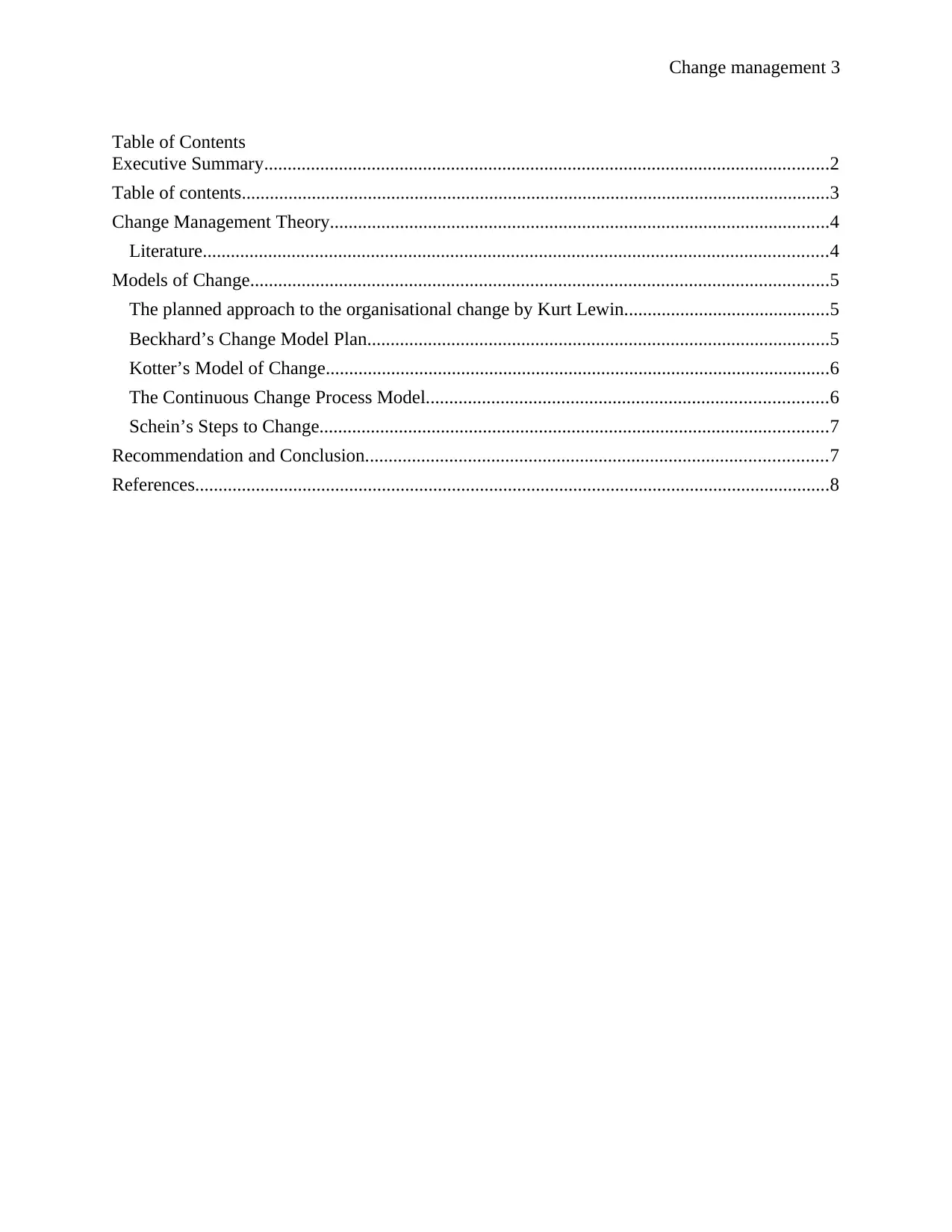
Change management 3
Table of Contents
Executive Summary.........................................................................................................................2
Table of contents..............................................................................................................................3
Change Management Theory...........................................................................................................4
Literature......................................................................................................................................4
Models of Change............................................................................................................................5
The planned approach to the organisational change by Kurt Lewin............................................5
Beckhard’s Change Model Plan...................................................................................................5
Kotter’s Model of Change............................................................................................................6
The Continuous Change Process Model......................................................................................6
Schein’s Steps to Change.............................................................................................................7
Recommendation and Conclusion...................................................................................................7
References........................................................................................................................................8
Table of Contents
Executive Summary.........................................................................................................................2
Table of contents..............................................................................................................................3
Change Management Theory...........................................................................................................4
Literature......................................................................................................................................4
Models of Change............................................................................................................................5
The planned approach to the organisational change by Kurt Lewin............................................5
Beckhard’s Change Model Plan...................................................................................................5
Kotter’s Model of Change............................................................................................................6
The Continuous Change Process Model......................................................................................6
Schein’s Steps to Change.............................................................................................................7
Recommendation and Conclusion...................................................................................................7
References........................................................................................................................................8
⊘ This is a preview!⊘
Do you want full access?
Subscribe today to unlock all pages.

Trusted by 1+ million students worldwide
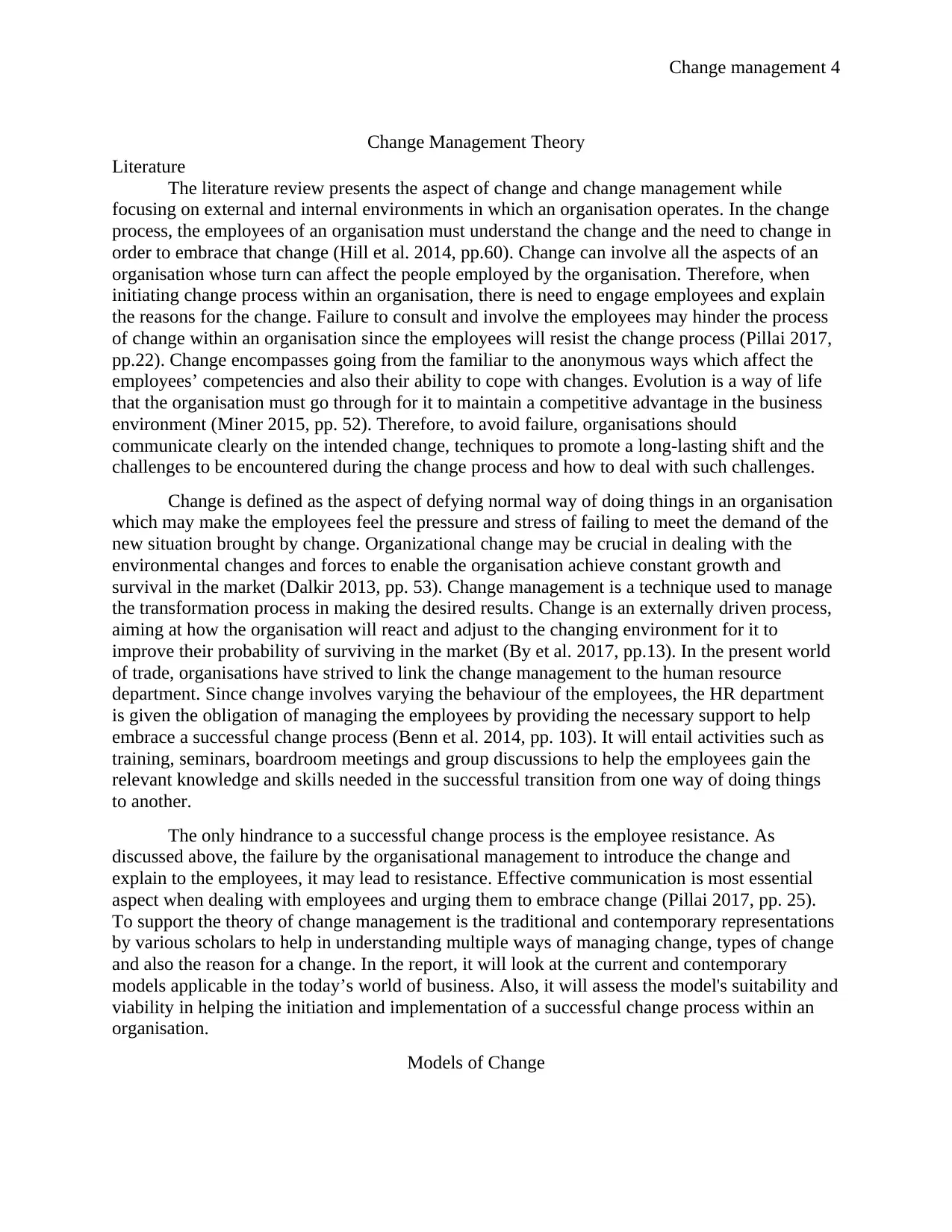
Change management 4
Change Management Theory
Literature
The literature review presents the aspect of change and change management while
focusing on external and internal environments in which an organisation operates. In the change
process, the employees of an organisation must understand the change and the need to change in
order to embrace that change (Hill et al. 2014, pp.60). Change can involve all the aspects of an
organisation whose turn can affect the people employed by the organisation. Therefore, when
initiating change process within an organisation, there is need to engage employees and explain
the reasons for the change. Failure to consult and involve the employees may hinder the process
of change within an organisation since the employees will resist the change process (Pillai 2017,
pp.22). Change encompasses going from the familiar to the anonymous ways which affect the
employees’ competencies and also their ability to cope with changes. Evolution is a way of life
that the organisation must go through for it to maintain a competitive advantage in the business
environment (Miner 2015, pp. 52). Therefore, to avoid failure, organisations should
communicate clearly on the intended change, techniques to promote a long-lasting shift and the
challenges to be encountered during the change process and how to deal with such challenges.
Change is defined as the aspect of defying normal way of doing things in an organisation
which may make the employees feel the pressure and stress of failing to meet the demand of the
new situation brought by change. Organizational change may be crucial in dealing with the
environmental changes and forces to enable the organisation achieve constant growth and
survival in the market (Dalkir 2013, pp. 53). Change management is a technique used to manage
the transformation process in making the desired results. Change is an externally driven process,
aiming at how the organisation will react and adjust to the changing environment for it to
improve their probability of surviving in the market (By et al. 2017, pp.13). In the present world
of trade, organisations have strived to link the change management to the human resource
department. Since change involves varying the behaviour of the employees, the HR department
is given the obligation of managing the employees by providing the necessary support to help
embrace a successful change process (Benn et al. 2014, pp. 103). It will entail activities such as
training, seminars, boardroom meetings and group discussions to help the employees gain the
relevant knowledge and skills needed in the successful transition from one way of doing things
to another.
The only hindrance to a successful change process is the employee resistance. As
discussed above, the failure by the organisational management to introduce the change and
explain to the employees, it may lead to resistance. Effective communication is most essential
aspect when dealing with employees and urging them to embrace change (Pillai 2017, pp. 25).
To support the theory of change management is the traditional and contemporary representations
by various scholars to help in understanding multiple ways of managing change, types of change
and also the reason for a change. In the report, it will look at the current and contemporary
models applicable in the today’s world of business. Also, it will assess the model's suitability and
viability in helping the initiation and implementation of a successful change process within an
organisation.
Models of Change
Change Management Theory
Literature
The literature review presents the aspect of change and change management while
focusing on external and internal environments in which an organisation operates. In the change
process, the employees of an organisation must understand the change and the need to change in
order to embrace that change (Hill et al. 2014, pp.60). Change can involve all the aspects of an
organisation whose turn can affect the people employed by the organisation. Therefore, when
initiating change process within an organisation, there is need to engage employees and explain
the reasons for the change. Failure to consult and involve the employees may hinder the process
of change within an organisation since the employees will resist the change process (Pillai 2017,
pp.22). Change encompasses going from the familiar to the anonymous ways which affect the
employees’ competencies and also their ability to cope with changes. Evolution is a way of life
that the organisation must go through for it to maintain a competitive advantage in the business
environment (Miner 2015, pp. 52). Therefore, to avoid failure, organisations should
communicate clearly on the intended change, techniques to promote a long-lasting shift and the
challenges to be encountered during the change process and how to deal with such challenges.
Change is defined as the aspect of defying normal way of doing things in an organisation
which may make the employees feel the pressure and stress of failing to meet the demand of the
new situation brought by change. Organizational change may be crucial in dealing with the
environmental changes and forces to enable the organisation achieve constant growth and
survival in the market (Dalkir 2013, pp. 53). Change management is a technique used to manage
the transformation process in making the desired results. Change is an externally driven process,
aiming at how the organisation will react and adjust to the changing environment for it to
improve their probability of surviving in the market (By et al. 2017, pp.13). In the present world
of trade, organisations have strived to link the change management to the human resource
department. Since change involves varying the behaviour of the employees, the HR department
is given the obligation of managing the employees by providing the necessary support to help
embrace a successful change process (Benn et al. 2014, pp. 103). It will entail activities such as
training, seminars, boardroom meetings and group discussions to help the employees gain the
relevant knowledge and skills needed in the successful transition from one way of doing things
to another.
The only hindrance to a successful change process is the employee resistance. As
discussed above, the failure by the organisational management to introduce the change and
explain to the employees, it may lead to resistance. Effective communication is most essential
aspect when dealing with employees and urging them to embrace change (Pillai 2017, pp. 25).
To support the theory of change management is the traditional and contemporary representations
by various scholars to help in understanding multiple ways of managing change, types of change
and also the reason for a change. In the report, it will look at the current and contemporary
models applicable in the today’s world of business. Also, it will assess the model's suitability and
viability in helping the initiation and implementation of a successful change process within an
organisation.
Models of Change
Paraphrase This Document
Need a fresh take? Get an instant paraphrase of this document with our AI Paraphraser
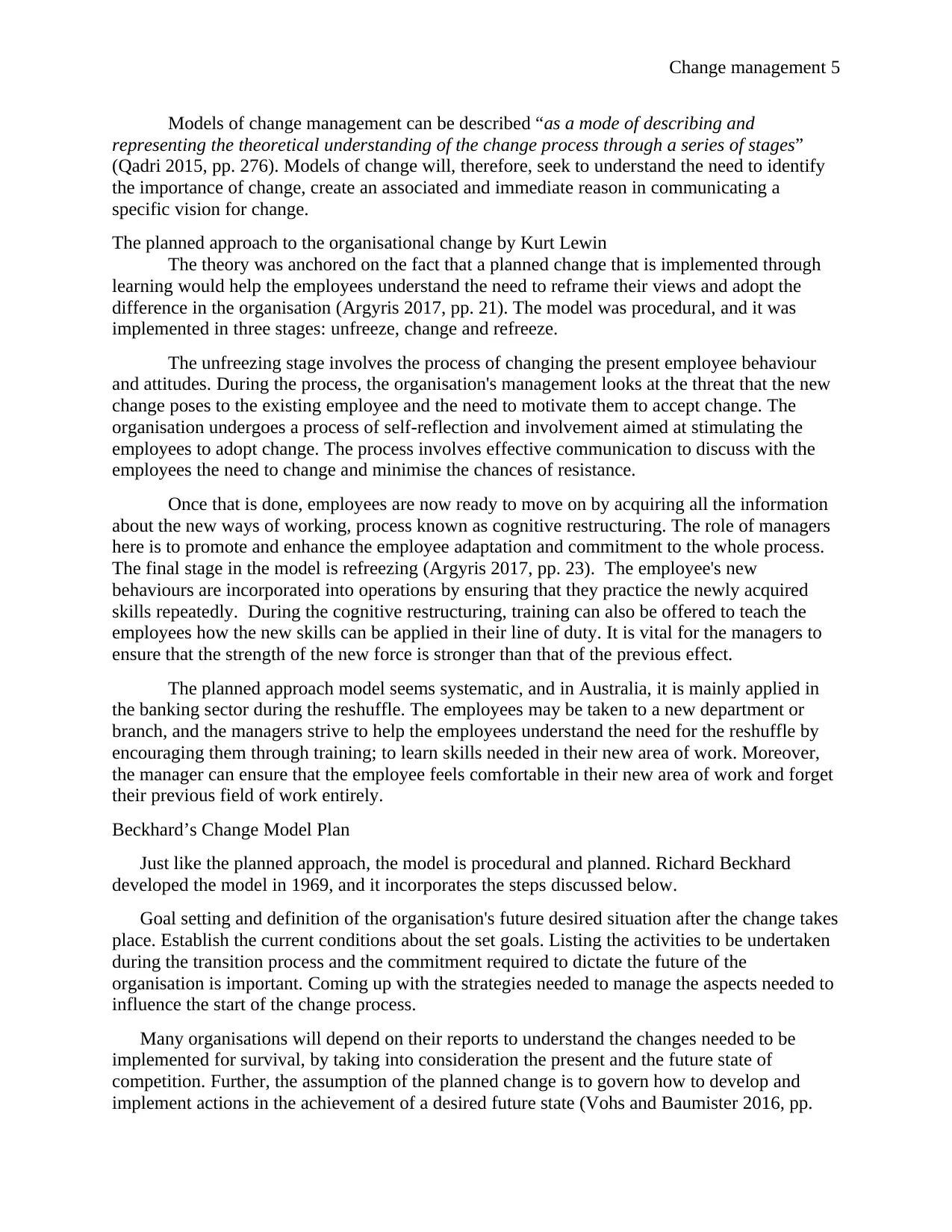
Change management 5
Models of change management can be described “as a mode of describing and
representing the theoretical understanding of the change process through a series of stages”
(Qadri 2015, pp. 276). Models of change will, therefore, seek to understand the need to identify
the importance of change, create an associated and immediate reason in communicating a
specific vision for change.
The planned approach to the organisational change by Kurt Lewin
The theory was anchored on the fact that a planned change that is implemented through
learning would help the employees understand the need to reframe their views and adopt the
difference in the organisation (Argyris 2017, pp. 21). The model was procedural, and it was
implemented in three stages: unfreeze, change and refreeze.
The unfreezing stage involves the process of changing the present employee behaviour
and attitudes. During the process, the organisation's management looks at the threat that the new
change poses to the existing employee and the need to motivate them to accept change. The
organisation undergoes a process of self-reflection and involvement aimed at stimulating the
employees to adopt change. The process involves effective communication to discuss with the
employees the need to change and minimise the chances of resistance.
Once that is done, employees are now ready to move on by acquiring all the information
about the new ways of working, process known as cognitive restructuring. The role of managers
here is to promote and enhance the employee adaptation and commitment to the whole process.
The final stage in the model is refreezing (Argyris 2017, pp. 23). The employee's new
behaviours are incorporated into operations by ensuring that they practice the newly acquired
skills repeatedly. During the cognitive restructuring, training can also be offered to teach the
employees how the new skills can be applied in their line of duty. It is vital for the managers to
ensure that the strength of the new force is stronger than that of the previous effect.
The planned approach model seems systematic, and in Australia, it is mainly applied in
the banking sector during the reshuffle. The employees may be taken to a new department or
branch, and the managers strive to help the employees understand the need for the reshuffle by
encouraging them through training; to learn skills needed in their new area of work. Moreover,
the manager can ensure that the employee feels comfortable in their new area of work and forget
their previous field of work entirely.
Beckhard’s Change Model Plan
Just like the planned approach, the model is procedural and planned. Richard Beckhard
developed the model in 1969, and it incorporates the steps discussed below.
Goal setting and definition of the organisation's future desired situation after the change takes
place. Establish the current conditions about the set goals. Listing the activities to be undertaken
during the transition process and the commitment required to dictate the future of the
organisation is important. Coming up with the strategies needed to manage the aspects needed to
influence the start of the change process.
Many organisations will depend on their reports to understand the changes needed to be
implemented for survival, by taking into consideration the present and the future state of
competition. Further, the assumption of the planned change is to govern how to develop and
implement actions in the achievement of a desired future state (Vohs and Baumister 2016, pp.
Models of change management can be described “as a mode of describing and
representing the theoretical understanding of the change process through a series of stages”
(Qadri 2015, pp. 276). Models of change will, therefore, seek to understand the need to identify
the importance of change, create an associated and immediate reason in communicating a
specific vision for change.
The planned approach to the organisational change by Kurt Lewin
The theory was anchored on the fact that a planned change that is implemented through
learning would help the employees understand the need to reframe their views and adopt the
difference in the organisation (Argyris 2017, pp. 21). The model was procedural, and it was
implemented in three stages: unfreeze, change and refreeze.
The unfreezing stage involves the process of changing the present employee behaviour
and attitudes. During the process, the organisation's management looks at the threat that the new
change poses to the existing employee and the need to motivate them to accept change. The
organisation undergoes a process of self-reflection and involvement aimed at stimulating the
employees to adopt change. The process involves effective communication to discuss with the
employees the need to change and minimise the chances of resistance.
Once that is done, employees are now ready to move on by acquiring all the information
about the new ways of working, process known as cognitive restructuring. The role of managers
here is to promote and enhance the employee adaptation and commitment to the whole process.
The final stage in the model is refreezing (Argyris 2017, pp. 23). The employee's new
behaviours are incorporated into operations by ensuring that they practice the newly acquired
skills repeatedly. During the cognitive restructuring, training can also be offered to teach the
employees how the new skills can be applied in their line of duty. It is vital for the managers to
ensure that the strength of the new force is stronger than that of the previous effect.
The planned approach model seems systematic, and in Australia, it is mainly applied in
the banking sector during the reshuffle. The employees may be taken to a new department or
branch, and the managers strive to help the employees understand the need for the reshuffle by
encouraging them through training; to learn skills needed in their new area of work. Moreover,
the manager can ensure that the employee feels comfortable in their new area of work and forget
their previous field of work entirely.
Beckhard’s Change Model Plan
Just like the planned approach, the model is procedural and planned. Richard Beckhard
developed the model in 1969, and it incorporates the steps discussed below.
Goal setting and definition of the organisation's future desired situation after the change takes
place. Establish the current conditions about the set goals. Listing the activities to be undertaken
during the transition process and the commitment required to dictate the future of the
organisation is important. Coming up with the strategies needed to manage the aspects needed to
influence the start of the change process.
Many organisations will depend on their reports to understand the changes needed to be
implemented for survival, by taking into consideration the present and the future state of
competition. Further, the assumption of the planned change is to govern how to develop and
implement actions in the achievement of a desired future state (Vohs and Baumister 2016, pp.
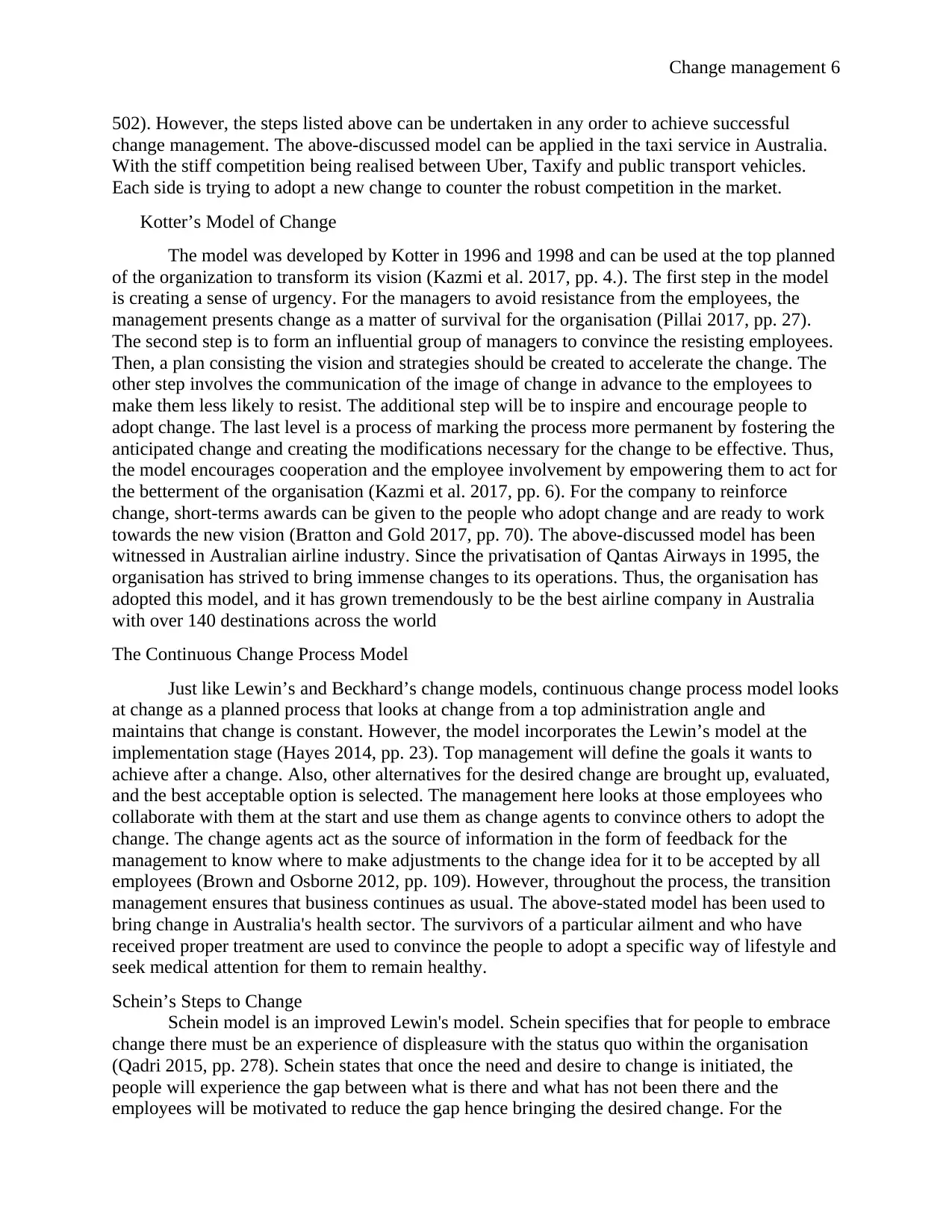
Change management 6
502). However, the steps listed above can be undertaken in any order to achieve successful
change management. The above-discussed model can be applied in the taxi service in Australia.
With the stiff competition being realised between Uber, Taxify and public transport vehicles.
Each side is trying to adopt a new change to counter the robust competition in the market.
Kotter’s Model of Change
The model was developed by Kotter in 1996 and 1998 and can be used at the top planned
of the organization to transform its vision (Kazmi et al. 2017, pp. 4.). The first step in the model
is creating a sense of urgency. For the managers to avoid resistance from the employees, the
management presents change as a matter of survival for the organisation (Pillai 2017, pp. 27).
The second step is to form an influential group of managers to convince the resisting employees.
Then, a plan consisting the vision and strategies should be created to accelerate the change. The
other step involves the communication of the image of change in advance to the employees to
make them less likely to resist. The additional step will be to inspire and encourage people to
adopt change. The last level is a process of marking the process more permanent by fostering the
anticipated change and creating the modifications necessary for the change to be effective. Thus,
the model encourages cooperation and the employee involvement by empowering them to act for
the betterment of the organisation (Kazmi et al. 2017, pp. 6). For the company to reinforce
change, short-terms awards can be given to the people who adopt change and are ready to work
towards the new vision (Bratton and Gold 2017, pp. 70). The above-discussed model has been
witnessed in Australian airline industry. Since the privatisation of Qantas Airways in 1995, the
organisation has strived to bring immense changes to its operations. Thus, the organisation has
adopted this model, and it has grown tremendously to be the best airline company in Australia
with over 140 destinations across the world
The Continuous Change Process Model
Just like Lewin’s and Beckhard’s change models, continuous change process model looks
at change as a planned process that looks at change from a top administration angle and
maintains that change is constant. However, the model incorporates the Lewin’s model at the
implementation stage (Hayes 2014, pp. 23). Top management will define the goals it wants to
achieve after a change. Also, other alternatives for the desired change are brought up, evaluated,
and the best acceptable option is selected. The management here looks at those employees who
collaborate with them at the start and use them as change agents to convince others to adopt the
change. The change agents act as the source of information in the form of feedback for the
management to know where to make adjustments to the change idea for it to be accepted by all
employees (Brown and Osborne 2012, pp. 109). However, throughout the process, the transition
management ensures that business continues as usual. The above-stated model has been used to
bring change in Australia's health sector. The survivors of a particular ailment and who have
received proper treatment are used to convince the people to adopt a specific way of lifestyle and
seek medical attention for them to remain healthy.
Schein’s Steps to Change
Schein model is an improved Lewin's model. Schein specifies that for people to embrace
change there must be an experience of displeasure with the status quo within the organisation
(Qadri 2015, pp. 278). Schein states that once the need and desire to change is initiated, the
people will experience the gap between what is there and what has not been there and the
employees will be motivated to reduce the gap hence bringing the desired change. For the
502). However, the steps listed above can be undertaken in any order to achieve successful
change management. The above-discussed model can be applied in the taxi service in Australia.
With the stiff competition being realised between Uber, Taxify and public transport vehicles.
Each side is trying to adopt a new change to counter the robust competition in the market.
Kotter’s Model of Change
The model was developed by Kotter in 1996 and 1998 and can be used at the top planned
of the organization to transform its vision (Kazmi et al. 2017, pp. 4.). The first step in the model
is creating a sense of urgency. For the managers to avoid resistance from the employees, the
management presents change as a matter of survival for the organisation (Pillai 2017, pp. 27).
The second step is to form an influential group of managers to convince the resisting employees.
Then, a plan consisting the vision and strategies should be created to accelerate the change. The
other step involves the communication of the image of change in advance to the employees to
make them less likely to resist. The additional step will be to inspire and encourage people to
adopt change. The last level is a process of marking the process more permanent by fostering the
anticipated change and creating the modifications necessary for the change to be effective. Thus,
the model encourages cooperation and the employee involvement by empowering them to act for
the betterment of the organisation (Kazmi et al. 2017, pp. 6). For the company to reinforce
change, short-terms awards can be given to the people who adopt change and are ready to work
towards the new vision (Bratton and Gold 2017, pp. 70). The above-discussed model has been
witnessed in Australian airline industry. Since the privatisation of Qantas Airways in 1995, the
organisation has strived to bring immense changes to its operations. Thus, the organisation has
adopted this model, and it has grown tremendously to be the best airline company in Australia
with over 140 destinations across the world
The Continuous Change Process Model
Just like Lewin’s and Beckhard’s change models, continuous change process model looks
at change as a planned process that looks at change from a top administration angle and
maintains that change is constant. However, the model incorporates the Lewin’s model at the
implementation stage (Hayes 2014, pp. 23). Top management will define the goals it wants to
achieve after a change. Also, other alternatives for the desired change are brought up, evaluated,
and the best acceptable option is selected. The management here looks at those employees who
collaborate with them at the start and use them as change agents to convince others to adopt the
change. The change agents act as the source of information in the form of feedback for the
management to know where to make adjustments to the change idea for it to be accepted by all
employees (Brown and Osborne 2012, pp. 109). However, throughout the process, the transition
management ensures that business continues as usual. The above-stated model has been used to
bring change in Australia's health sector. The survivors of a particular ailment and who have
received proper treatment are used to convince the people to adopt a specific way of lifestyle and
seek medical attention for them to remain healthy.
Schein’s Steps to Change
Schein model is an improved Lewin's model. Schein specifies that for people to embrace
change there must be an experience of displeasure with the status quo within the organisation
(Qadri 2015, pp. 278). Schein states that once the need and desire to change is initiated, the
people will experience the gap between what is there and what has not been there and the
employees will be motivated to reduce the gap hence bringing the desired change. For the
⊘ This is a preview!⊘
Do you want full access?
Subscribe today to unlock all pages.

Trusted by 1+ million students worldwide
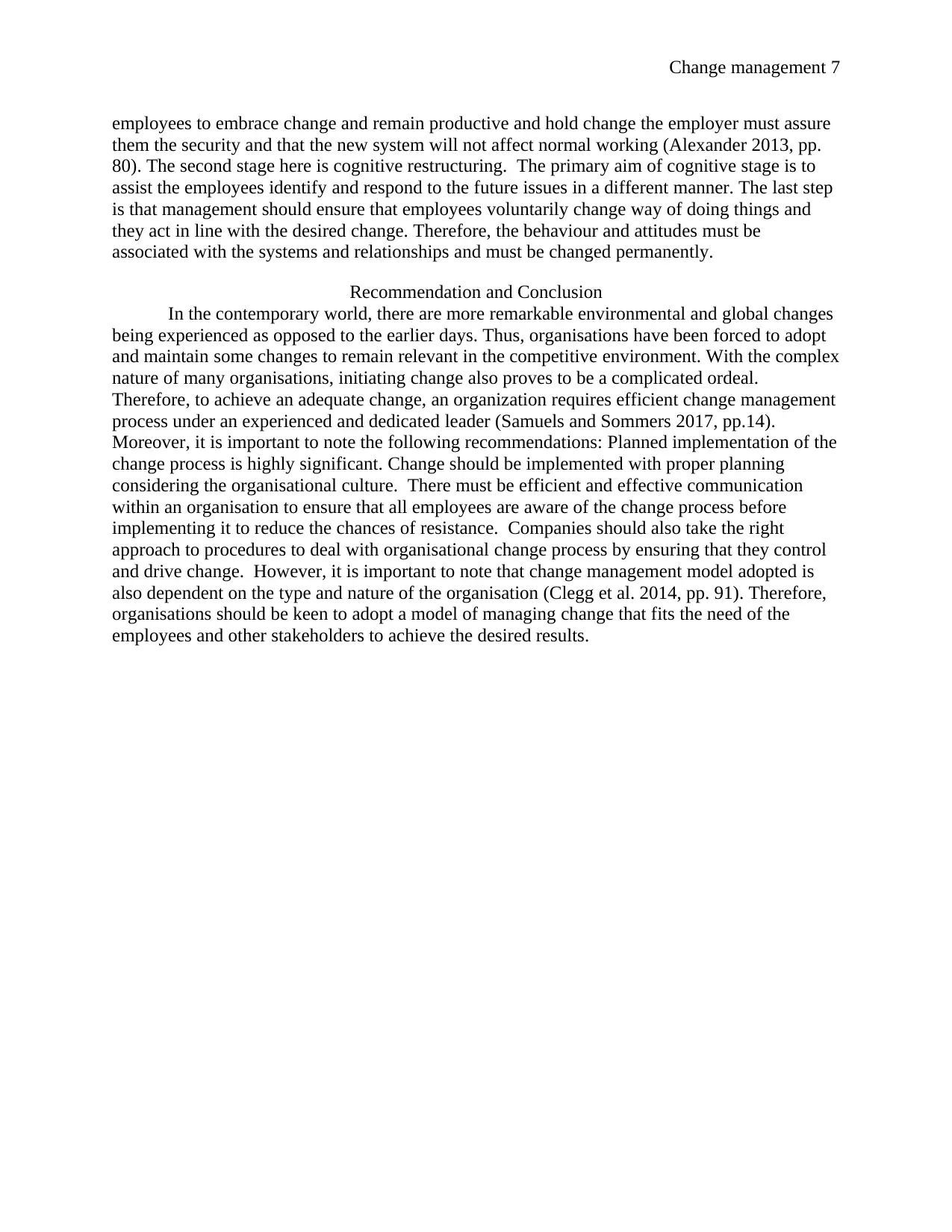
Change management 7
employees to embrace change and remain productive and hold change the employer must assure
them the security and that the new system will not affect normal working (Alexander 2013, pp.
80). The second stage here is cognitive restructuring. The primary aim of cognitive stage is to
assist the employees identify and respond to the future issues in a different manner. The last step
is that management should ensure that employees voluntarily change way of doing things and
they act in line with the desired change. Therefore, the behaviour and attitudes must be
associated with the systems and relationships and must be changed permanently.
Recommendation and Conclusion
In the contemporary world, there are more remarkable environmental and global changes
being experienced as opposed to the earlier days. Thus, organisations have been forced to adopt
and maintain some changes to remain relevant in the competitive environment. With the complex
nature of many organisations, initiating change also proves to be a complicated ordeal.
Therefore, to achieve an adequate change, an organization requires efficient change management
process under an experienced and dedicated leader (Samuels and Sommers 2017, pp.14).
Moreover, it is important to note the following recommendations: Planned implementation of the
change process is highly significant. Change should be implemented with proper planning
considering the organisational culture. There must be efficient and effective communication
within an organisation to ensure that all employees are aware of the change process before
implementing it to reduce the chances of resistance. Companies should also take the right
approach to procedures to deal with organisational change process by ensuring that they control
and drive change. However, it is important to note that change management model adopted is
also dependent on the type and nature of the organisation (Clegg et al. 2014, pp. 91). Therefore,
organisations should be keen to adopt a model of managing change that fits the need of the
employees and other stakeholders to achieve the desired results.
employees to embrace change and remain productive and hold change the employer must assure
them the security and that the new system will not affect normal working (Alexander 2013, pp.
80). The second stage here is cognitive restructuring. The primary aim of cognitive stage is to
assist the employees identify and respond to the future issues in a different manner. The last step
is that management should ensure that employees voluntarily change way of doing things and
they act in line with the desired change. Therefore, the behaviour and attitudes must be
associated with the systems and relationships and must be changed permanently.
Recommendation and Conclusion
In the contemporary world, there are more remarkable environmental and global changes
being experienced as opposed to the earlier days. Thus, organisations have been forced to adopt
and maintain some changes to remain relevant in the competitive environment. With the complex
nature of many organisations, initiating change also proves to be a complicated ordeal.
Therefore, to achieve an adequate change, an organization requires efficient change management
process under an experienced and dedicated leader (Samuels and Sommers 2017, pp.14).
Moreover, it is important to note the following recommendations: Planned implementation of the
change process is highly significant. Change should be implemented with proper planning
considering the organisational culture. There must be efficient and effective communication
within an organisation to ensure that all employees are aware of the change process before
implementing it to reduce the chances of resistance. Companies should also take the right
approach to procedures to deal with organisational change process by ensuring that they control
and drive change. However, it is important to note that change management model adopted is
also dependent on the type and nature of the organisation (Clegg et al. 2014, pp. 91). Therefore,
organisations should be keen to adopt a model of managing change that fits the need of the
employees and other stakeholders to achieve the desired results.
Paraphrase This Document
Need a fresh take? Get an instant paraphrase of this document with our AI Paraphraser
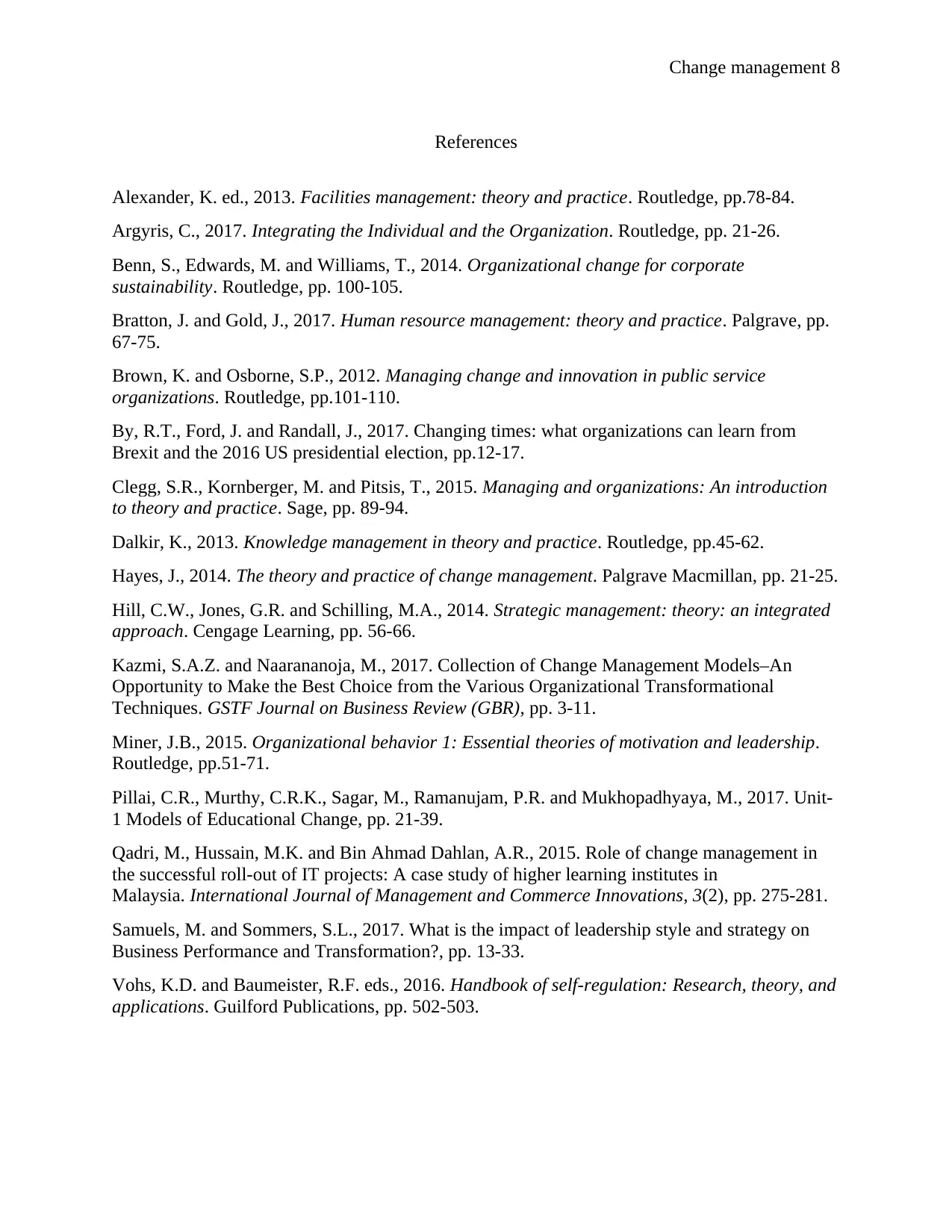
Change management 8
References
Alexander, K. ed., 2013. Facilities management: theory and practice. Routledge, pp.78-84.
Argyris, C., 2017. Integrating the Individual and the Organization. Routledge, pp. 21-26.
Benn, S., Edwards, M. and Williams, T., 2014. Organizational change for corporate
sustainability. Routledge, pp. 100-105.
Bratton, J. and Gold, J., 2017. Human resource management: theory and practice. Palgrave, pp.
67-75.
Brown, K. and Osborne, S.P., 2012. Managing change and innovation in public service
organizations. Routledge, pp.101-110.
By, R.T., Ford, J. and Randall, J., 2017. Changing times: what organizations can learn from
Brexit and the 2016 US presidential election, pp.12-17.
Clegg, S.R., Kornberger, M. and Pitsis, T., 2015. Managing and organizations: An introduction
to theory and practice. Sage, pp. 89-94.
Dalkir, K., 2013. Knowledge management in theory and practice. Routledge, pp.45-62.
Hayes, J., 2014. The theory and practice of change management. Palgrave Macmillan, pp. 21-25.
Hill, C.W., Jones, G.R. and Schilling, M.A., 2014. Strategic management: theory: an integrated
approach. Cengage Learning, pp. 56-66.
Kazmi, S.A.Z. and Naarananoja, M., 2017. Collection of Change Management Models–An
Opportunity to Make the Best Choice from the Various Organizational Transformational
Techniques. GSTF Journal on Business Review (GBR), pp. 3-11.
Miner, J.B., 2015. Organizational behavior 1: Essential theories of motivation and leadership.
Routledge, pp.51-71.
Pillai, C.R., Murthy, C.R.K., Sagar, M., Ramanujam, P.R. and Mukhopadhyaya, M., 2017. Unit-
1 Models of Educational Change, pp. 21-39.
Qadri, M., Hussain, M.K. and Bin Ahmad Dahlan, A.R., 2015. Role of change management in
the successful roll-out of IT projects: A case study of higher learning institutes in
Malaysia. International Journal of Management and Commerce Innovations, 3(2), pp. 275-281.
Samuels, M. and Sommers, S.L., 2017. What is the impact of leadership style and strategy on
Business Performance and Transformation?, pp. 13-33.
Vohs, K.D. and Baumeister, R.F. eds., 2016. Handbook of self-regulation: Research, theory, and
applications. Guilford Publications, pp. 502-503.
References
Alexander, K. ed., 2013. Facilities management: theory and practice. Routledge, pp.78-84.
Argyris, C., 2017. Integrating the Individual and the Organization. Routledge, pp. 21-26.
Benn, S., Edwards, M. and Williams, T., 2014. Organizational change for corporate
sustainability. Routledge, pp. 100-105.
Bratton, J. and Gold, J., 2017. Human resource management: theory and practice. Palgrave, pp.
67-75.
Brown, K. and Osborne, S.P., 2012. Managing change and innovation in public service
organizations. Routledge, pp.101-110.
By, R.T., Ford, J. and Randall, J., 2017. Changing times: what organizations can learn from
Brexit and the 2016 US presidential election, pp.12-17.
Clegg, S.R., Kornberger, M. and Pitsis, T., 2015. Managing and organizations: An introduction
to theory and practice. Sage, pp. 89-94.
Dalkir, K., 2013. Knowledge management in theory and practice. Routledge, pp.45-62.
Hayes, J., 2014. The theory and practice of change management. Palgrave Macmillan, pp. 21-25.
Hill, C.W., Jones, G.R. and Schilling, M.A., 2014. Strategic management: theory: an integrated
approach. Cengage Learning, pp. 56-66.
Kazmi, S.A.Z. and Naarananoja, M., 2017. Collection of Change Management Models–An
Opportunity to Make the Best Choice from the Various Organizational Transformational
Techniques. GSTF Journal on Business Review (GBR), pp. 3-11.
Miner, J.B., 2015. Organizational behavior 1: Essential theories of motivation and leadership.
Routledge, pp.51-71.
Pillai, C.R., Murthy, C.R.K., Sagar, M., Ramanujam, P.R. and Mukhopadhyaya, M., 2017. Unit-
1 Models of Educational Change, pp. 21-39.
Qadri, M., Hussain, M.K. and Bin Ahmad Dahlan, A.R., 2015. Role of change management in
the successful roll-out of IT projects: A case study of higher learning institutes in
Malaysia. International Journal of Management and Commerce Innovations, 3(2), pp. 275-281.
Samuels, M. and Sommers, S.L., 2017. What is the impact of leadership style and strategy on
Business Performance and Transformation?, pp. 13-33.
Vohs, K.D. and Baumeister, R.F. eds., 2016. Handbook of self-regulation: Research, theory, and
applications. Guilford Publications, pp. 502-503.
1 out of 8
Related Documents
Your All-in-One AI-Powered Toolkit for Academic Success.
+13062052269
info@desklib.com
Available 24*7 on WhatsApp / Email
![[object Object]](/_next/static/media/star-bottom.7253800d.svg)
Unlock your academic potential
Copyright © 2020–2025 A2Z Services. All Rights Reserved. Developed and managed by ZUCOL.




